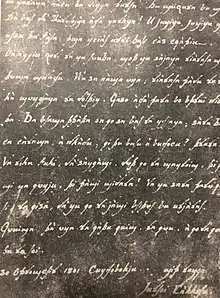Vellara alphabet
Vellara script or Vellara alphabet is one of the original Albanian alphabets, encountered for the first time in early 19th century. It is named after the Greek doctor, lyricist and writer Ioannis Vilaras (Jan Vellara in Albanian),[1] the author of a manuscript where this alphabet is documented for the first and so far the only time.

Ioannis Vilaras
Vilaras studied medicine in Padua in 1789 and later lived in Venice. In 1801, he became a physician to Veli, son of Ali Pasha Tepelena (1741–1822).[2] Vilaras is remembered primarily as a modern Greek poet, non-native Albanian speaker but fluent, according to François Pouqueville, who also describes him as bright. Vilaras spent time in southern Albania.[3]
The manuscript
The manuscript of the work was donated to the Bibliothèque Nationale in Paris (supplément grec 251, f. 138-187) in 1819 by François Pouqueville (1770–1839), French consul in Janina during the reign of Ali Pasha. Pouqueville was aware of the value of the work, noting: "Je possède un manuscrit, une grammaire grecque vulgaire et schype qui pourrait être utile aux philologues" (I possess a manuscript, a vulgar Greek and Albanian which could be of use to philologists), but chose not to publish it in his travel narratives. Pages 137-226 contain the material in Albanian.[3]
Pages 137-138 contain a list of proverbs in modern Greek and Albanian. Pages 138-187, in two columns per page format, contain the collection of grammatical notes both in Greek and Albanian. These bilingual grammatical notes, dated 1801, were designed no doubt to teach other Greek-speakers Albanian. On page 187, there is a list of names of living things. Page 191 starts the Greek-Albanian phraseologies. On page 217, there is a mini-dictionary with trees names, human body parts, and vegetable names. The alphabet shows in page 219. Appendixed to the grammatical notes is also a letter dated 30 October 1801, written in Albanian in Vellara's handwriting from the village of Vokopolë, south of Berat, where the physician had been obliged to follow Veli during the latter's military campaign against Ibrahim of Berat.
The alphabet
The alphabet comprises 30 letters. It leans towards the Latin script, and less the Greek one, with some special characters for Albanian's particular sounds. Albanian alphabet's "c" and "x" are covered by a single letter ("x" is never found in Vellara's writings). Today's "ë" is represented by "e", and "e" by "é". There are no letters for today's digraphs "ll", "rr", "zh", and "y". Instead, "y" is substituted with "u" or "i". Today's "nj" is represented by a Cyrillic letter.[3]
History
The first scholar to study the script was the French geographer Conrad Malte-Brun in his Universal Geograpraphy (1827). He thought that the script is without doubt an ecclesiastical one (and not Vellara's original), which resembles ancient alphabets, and emerged during important milestones that Christianity passed in the area.[4]
"But there is, if we may so term it, an ecclesiastical alphabet, which consists of thirty lettes; and many of them are not unlike the Phoenician, Hebrew, Armenian or Palmyrenian characters; few of them have resemblance with the Bulgarian or Moesogothic, and we look in vain for the Pelasgic, Etruscian or Runic letters. This alphabet in its present form, was probably constructed by Christian priests, either in the second century when Christianity was introduced into the country, or in the ninth, when the Albanian church was united with that of Rome; but is evidently derived from other alphabets, much more ancient, which at one period were used in Illyria, Macedonia, and Epirus."
Vilara's letter signed by him as "30 Oktomvrit 1801 Vagopolja, mik tëndë Jatroi Vellara" (October 30, 1801, Vokopolja, your friend Doctor Vellara), shows that the alphabet was known and used by other people at that time.
During the Albanian National Renaissance, the script was made known to the Albanian circles, first published in 1898 by the Albania magazine in Brussels.[3][1]
References
- Studime Filologjike. Akademia e Shkencave e RPSSH, Instituti i Gjuhesise dhe i Letersise. 1964. p. 198.
Në lidhje me këtë, E. Legrandi i shkruen revistës, se Dr. Vellara, asht njeri i njoftun dhe nuk asht shqiptar. Emni i tij i vërtetë asht Joannis Vellara...
- Bruce Merry (2004). Encyclopedia of Modern Greek Literature. Greenwood Publishing Group. pp. 457–458. ISBN 978-0-313-30813-0.
- Dhimiter Shuteriqi (1976), Shkrimet Shqipe ne Vitet 1332-1850, Tirana: Academy of Sciences of PR of Albania, pp. 151–152, OCLC 252881121
- Conrad Malte-Brun; Jean-Jacques-Nicolas Huot (1834). A system of universal geography: or A description of all the parts of the world, on a new plan, according to the great natural divisions of the globe. S. Walker. pp. 421–.